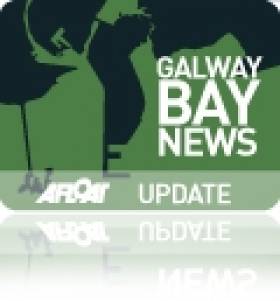Displaying items by tag: Lasta Mara TEO
#AranFreighters - Ireland’s Iargest domestic coastal cargoship finally returned to Galway-Aran Islands service following more than one month of maintenance carried out in the mid-west port, writes Jehan Ashmore.
The 330 gross tonnage Bláth na Mara operated by Lasta Mara Teoranta, had beforehand had hull works carried out in March at Mooney Boats. The ship was hoisted out of the water at the facility in Killybegs Co. Donegal and transferred by rail away from the quayside for the works.
Afloat had monitored the 36m vessel’s resumption yesterday in bringing essential supplies to all three Aran Islands: Inishmore, Inis Meain and Inis Oirr. This saw a sailing head first for the main island of Inishmore. On completion of discharging cargo in Kilronan Harbour, it was then an anti-clockwise route taken to the smaller isles before returning across Galway Bay.
Also operating these services until this morning was fleetmate Chateau Thierry, a roll on / roll-off vessel that carried out relief cover while the larger vessel received further attention.
As there is no slipway facilities in Galway Port, cargo loading of the ro-ro Chateau Thierry instead required use of its deck-mounted crane to load cargo from the harbour’s outer pier.
Chateau Thierry is to resume routine sailings to the Aran Islands based out of Rossaveel.
Three’s A Crowd as Naval, Research and Cargo Ships Dock In Galway
Also sharing the basin but located closer to the dock gates was Arklow Shipping Ltd's Dutch registered dry-cargo vessel Arklow Surf (2000/2,316grt). The dock is capable of handling more vessels simultaneously and of course used as a host-port of the high-profile Volvo Ocean Race which is due to return next year.
Galway and neighbouring Limerick City with its Ted Russell Dock, are the only dock-gate accessed ports on the island of Ireland. In the case of Galway there is an exception as freight operations are also available from an outer pier on the seaward side of Dún Aengus Dock though only for domestic purposes. From this pier the dedicated Aran Islands freight service is operated by Lasta Mara TEO's Blath na Mara (1983/330grt). As for Limerick, vessels can also berth outside the dock but they tend to be small port-work related craft that use the outer berth on the Shannon Estuary.
The Galway Harbour Company in recent years have proposed plans for a new outer port, to be built in four stages with a completion date set for 2017. This would enable larger deeper drafted vessels such as tankers and cruiseships to dock in the new port. In the meantime cruiseships anchor off Mutton Island. In addition a freight rail-link, berthing for an inshore fishing fleet and a 216 berth marina are proposed.
To read more about the port proposals visit http://www.galwayharbour.com/news.php?id=11and for aerial visual impressions click HERE.
- River Shannon
- Marine Institute
- naval service
- Ports and Shipping
- Arklow Shipping Ltd
- Ports and Shipping News
- Aran Islands
- Island News
- Galway Bay News
- Marine Science News
- Dun Aengus Dock
- Galway Harbour Company
- Cruise Liner news
- Cruise ships
- Galway Harbour and Bay news
- Ted Russell Dock
- Marine Instistute Research vessels
- Lasta Mara TEO






























































